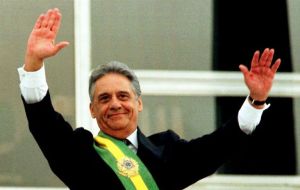MercoPress. South Atlantic News Agency
Brazil's currency Real turned 25 this month, a true feat for a country whipped for decades with inflation
 The birth certificate of the Real is dated July 1, 1994, but the monetary unit had a previous chapter, the URV (Real Unit of Value), which helped with transition
The birth certificate of the Real is dated July 1, 1994, but the monetary unit had a previous chapter, the URV (Real Unit of Value), which helped with transition  The success of the new stable currency helped the Finance minister, Henrique Fernando Cardoso, to be elected president in 1994
The success of the new stable currency helped the Finance minister, Henrique Fernando Cardoso, to be elected president in 1994 Brazil’s Real turned 25 years on Monday, July first. It’s already the longest circulating currency in the contemporary history of Brazil, having achieved this feat without fanfare in 2018 when it surpassed the cruzeiro.
The cruzeiro lasted 24 years. By coincidence, it went into circulation and exited under dictatorships. It was created in November 1942, during the Estado Novo de Getúlio Vargas, and killed off in February 1967 under the government of General Castello Branco. The new cruzeiro came into circulation to reduce nominally the numbers swollen by inflation during previous years.
If we consider the remote past, the real only loses to the milreis, in circulation in Brazil from the middle of the colonial period until 1942. Mil-reis was a popular unit of account, a multiple of Real, which lent its name to the current currency.
The birth certificate of the real is dated July 1, 1994, but the monetary unit had an important embryonic life - the URV (Real Unit of Value) - that, more than anticipating its name, made the transition with the previous coin, the cruzeiro.
Considered a prodigy of economic engineering, the gimmick, launched three months earlier, allowed society to gradually to abandon the devalued currency and migrate to a stable index.
The Real Plan, from which the currency came, was a collective work. Economists, like Edmar Bacha, André Lara Resende, Pérsio Arida and Gustavo Franco, collaborated and worked with the Minister of Finance Fernando Henrique Cardoso, the bridge between the technical team and then president Itamar Franco.
After at least a decade battling inflation, the plan was a success and soon brought down four-digit rates to levels similar to those in developed countries. Finance minister Cardoso taking advantage of success went on to be elected Brazilian president in 1994.




Top Comments
Disclaimer & comment rulesCommenting for this story is now closed.
If you have a Facebook account, become a fan and comment on our Facebook Page!